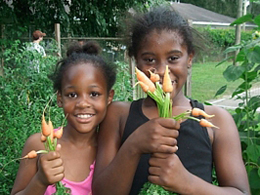Food Environment and Childhood Obesity
HEAT's work on the food environment builds on many years of work by key community partners, including long-standing collaborations between the Greater Frenchtown Revitalization Council, the Damayan Garden Project, and the Leon County Health Department. In 2009, researchers from the University of Florida joined this partnership to improve our understanding of how neighborhood food environments shape the options for healthy eating in Tallahassee.
This work is also motivated by growing concern about childhood obesity—in Leon County and in the United States as a whole. Childhood obesity is often treated as a matter of individual choices about diet and exercise, but there is growing evidence that access to healthy foods and physical activity are constrained by environmental factors, such as the location of grocery stores, transportation, and safety. We are beginning to collect evidence about the food environment in Leon County, with the goal of informing policies that will increase access to healthy foods and reduce childhood obesity.
HEAT's work so far has been funded by a grant from the Blue Cross and Blue Shield of Florida Foundation to the Leon County Health Department (LCHD).
Background
Childhood obesity is among the most pressing public health problems in the United States. Nearly one-third of American youth are either overweight or obese. Obesity in childhood and adolescence is associated with a greater risk of chronic diseases in adulthood, including diabetes, heart disease, and certain cancers.
Childhood obesity is also a significant public health issue in Leon County. Consider these facts:- 11.1% of middle school students and 14.7% of high school students in Leon County are obese.
- 87.9% of middle and high school students do not eat at least 5 fruits and vegetables every day.
- 56.1% of adults are overweight or obese.
The good news is that there are many ways we can help to reduce childhood obesity. People working in other communities have shown that they can do a lot to improve the food environment. Some example of strategies that have worked include working with store owners to change the foods they sell, working with policy makers to attract new grocery stores, planting community gardens to grow local food, and improving access to farmers markets. We want to build partnerships with people in the community to increase access to healthy food choices. To make effective changes, we have to start by knowing what the issues are and how people in the community think about food choices.
Research Activities
HEAT partners have carried out five different types of data collection to improve our understanding of neighborhood food environments in Tallahassee.- Location of retail food outlets. We developed a geographic information system (GIS) to map the location of supermarkets, grocery stores, and convenient stores throughout Leon County.
- Quality of food choices in stores.The Leon County Health Department and young people working with the Greater Frenchtown Revitalization Council assessed the choices people have in local food stores, using the Nutritional Environment Measures Survey (NEMS). Preliminary results show that healthy foods (e.g., fruits and vegetables, low-fat dairy products) are less available in low-income neighborhoods.
- Perspectives from store managers and low-income households. We interviewed managers and owners of local food stores to elicit their perspectives on healthy foods and to understand their decision-making about how to stock, price, and promote different foods. The key themes that emerged from these interviews correspond to four levels of policy intervention: (1) store and business factors, (2) economic factors, (3) individual and family-level factors, and (4) community factors. We are preparing results now to share with the community and other researchers.
- Household food receipts. We collected food receipts from low-income families to estimate household food expenditures and dietary intake over a four-week period. Preliminary analysis of these receipts showed that processed foods and sugar-sweetened beverages were the most common line items.
- Perspectives from residents in low-income neighborhoods.We conducted five focus groups with residents of low-income neighborhoods in Tallahassee to understand how they shop for and prepare foods for their families. We sought participants’ perspectives on the food environment, childhood obesity, and strategies for promoting healthy eating. Residents emphasized the importance of cost, time and resource constraints, and family organization. They also expressed a sophisticated understanding of how place matters, noting that access to healthy foods is often limited in poor neighborhoods. We plan to report back to the community and other researchers this year.
Community Engagement
The work of key community partners has continued and expanded along with our research activities.- Community engagement workshops. In spring 2010, HEAT partners organized a series of community engagement workshops and town hall meetings to share our findings and solicit community input on barriers to healthy eating.
- Food Policy Council. The Tallahassee Food Policy Council began as a spinoff of HEAT's work on the local food environment. The goal of the Food Policy Council is to advocate for policies that will improve the accessibility, affordability, and awareness of nutritous foods to Leon County residents while promoting a healthy, environmentally and economically sustainable community.
- Community gardening. Community gardens are flourishing, and many HEAT partners part of the movement to strengthen the local food system in Leon County.









